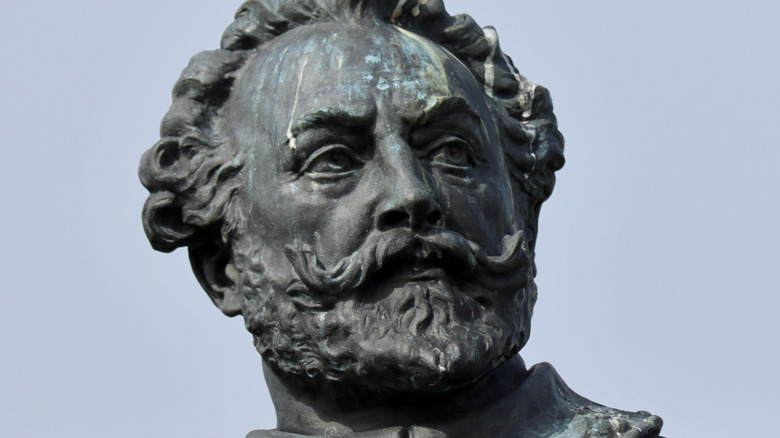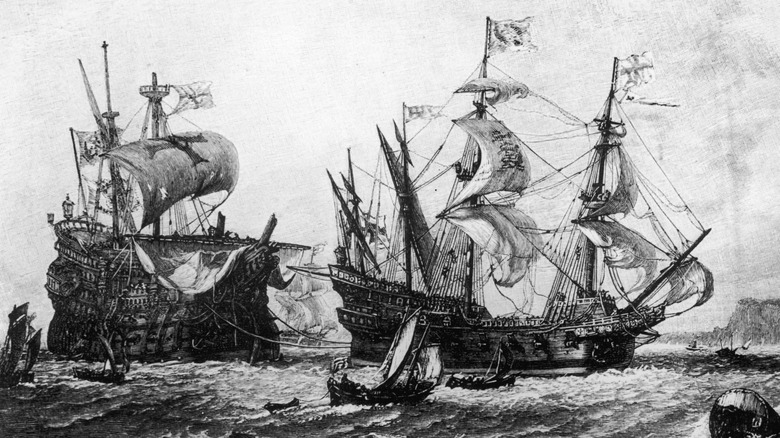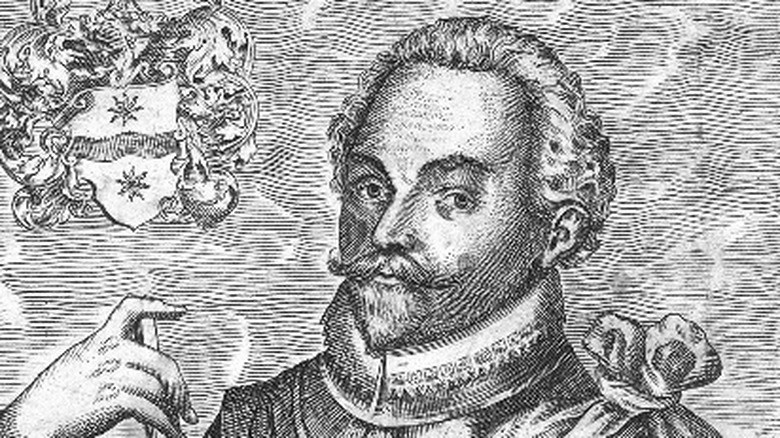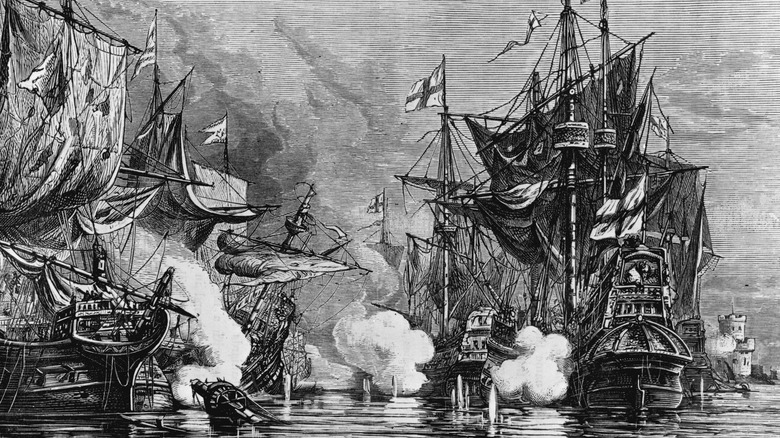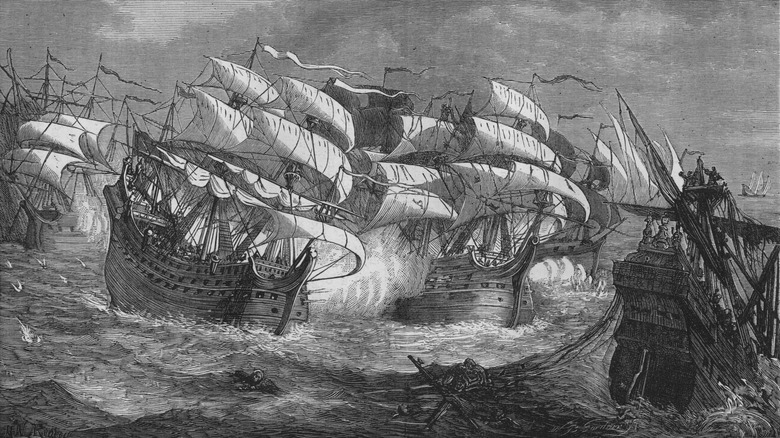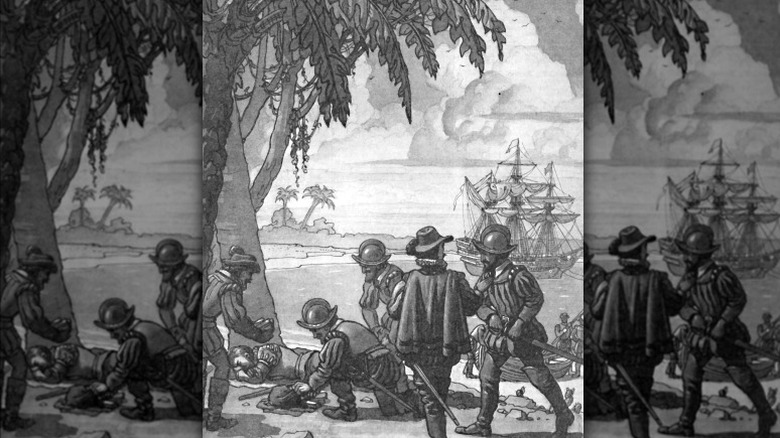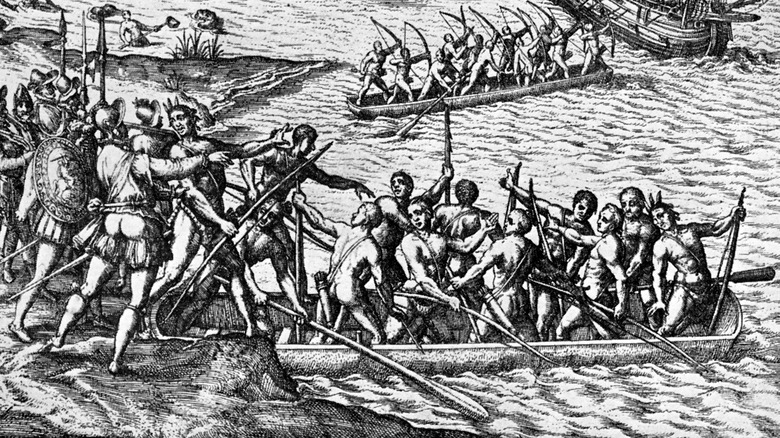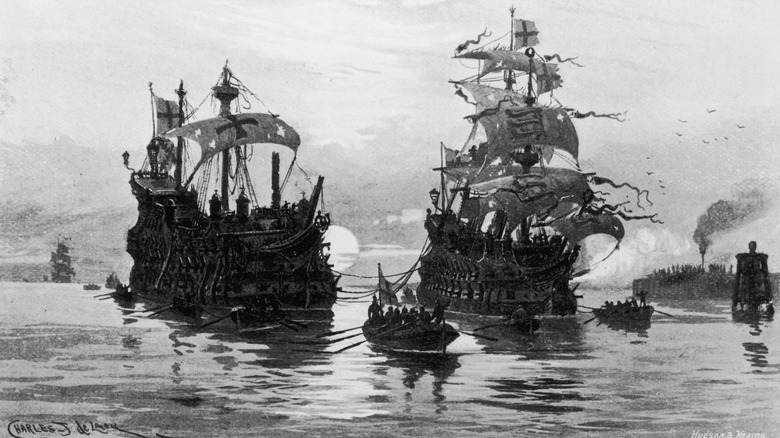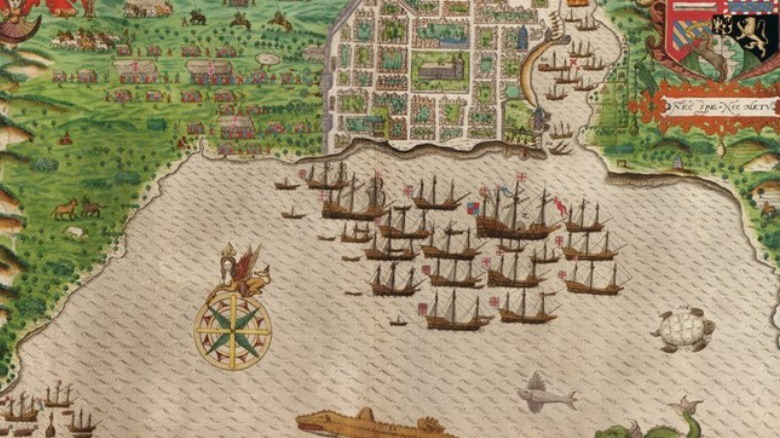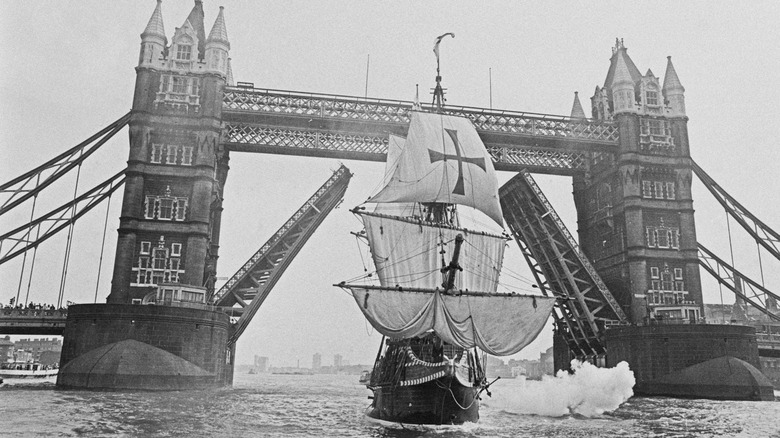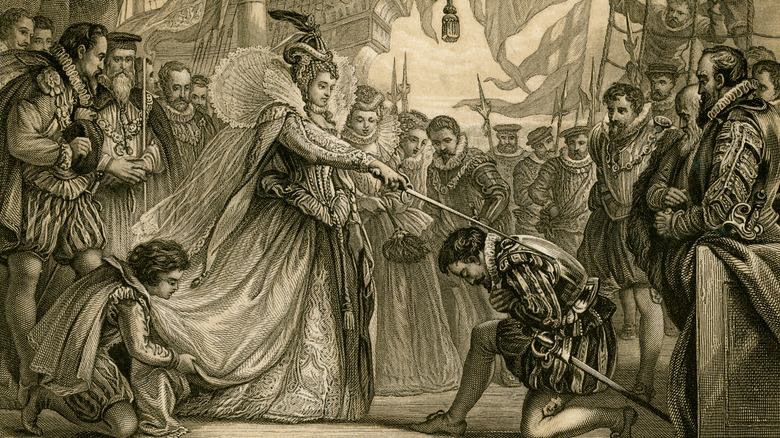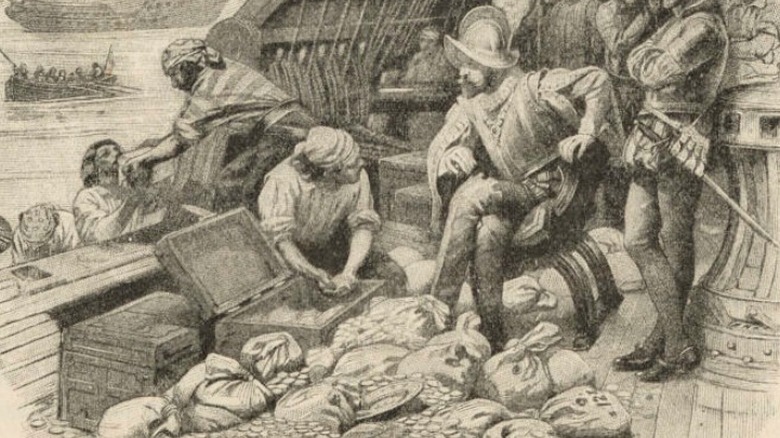The True Story Of Sir Francis Drake's Circumnavigation
Ferdinand Magellan gets all the credit for being the first human to circumnavigate the globe, but as National Geographic tells us, this isn't necessarily true. Sure, his expedition made it around the globe, but by the end, only 18 men were still alive, and the captain was no longer Magellan — who had died. Rather, it was Juan Sebastián Elcano who completed the journey, having assumed the captaincy in Magellan's stead. A few more Spanish expeditions and 60 years later, Sir Francis Drake became the first Englishman to make the voyage, and — unlike Magellan — he actually made it all the way.
The dissimilarities don't end there, however. Magellan has a very mixed legacy, mostly by way of how he treated the native peoples that he encountered. For the most part, Sir Francis Drake was the complete opposite, making his circumnavigation not one of scorched earth, but one of friendliness and something at least partially resembling diplomacy. Then there's the matter of Drake being a privateer — one of the most successful to have ever lived — as well as being one of Queen Elizabeth I's favorite people, per World History Encyclopedia. And given how no-nonsense she was, it was quite the feat to be appreciated in such a way.
Sir Francis Drake had one of the most successful and fruitful careers of any sailor in history, but it's the circumnavigation that serves as his crowning achievement. Here's the true story of his voyage.
A history of seaward successes
Francis Drake had a long track record of being an expert captain, who pretty much always accomplished his task. In the late 16th century, with tensions baking between Spain and England but no formal war declared, Queen Elizabeth I gave something of an open invitation to able-bodied seaman to work as pirates, on behalf of the crown, as long as they were targeting the Spanish treasure fleet, according to World History Encyclopedia.
Drake seized the opportunity and immediately set about raiding Spanish vessels with an incredible success rate, and in the process became the first Englishman to see the Pacific Ocean — all things that look pretty good on a resume. So when Richard Grenville proposed a plan to Queen Elizabeth to explore the supposed continent south of the equator, it was simple enough to decide on who to turn to, according to World History Encyclopedia. Elizabeth asked the man who was already accomplished at bringing her great fortunes, this skill being accompanied with dealing serious blows to the Spanish treasure fleet: that man was Francis Drake.
A simple mission
Francis Drake's mission, given by Queen Elizabeth I, was not actually to circumnavigate the globe. According to History, the objective was simply to go to the other side of the Spanish New World — the Pacific side — and do some casual raiding, with a side order of exploration. Simple enough, it seemed, and the order came from the Queen of England herself, per World History Encyclopedia. The Spanish had, after all, been allowed to develop along the Pacific side of America completely unchecked, and their holdings over there were very poorly defended, since they'd never had company before.
With five ships in his small fleet, Drake set out on December 13, 1577 to do what he had already done so many times before — accumulate some serious wealth for England, while denting the haul that the Spanish were taking home. The voyage across the Atlantic Ocean was anything but easy: Drake decided to leave two of his ships in South America, and another two were lost after a collection of crushing storms, experienced while they passed through the Strait of Magellan. By the time he reached the Pacific, he was left with just his own ship: the Golden Hind.
Easy pickings in the Pacific
Francis Drake may have made picking off Spanish treasures in the Atlantic theater look easy, but that doesn't mean it was. The Spanish treasure fleet was large and formidable, so while they may have been spread thin, they were by no means defenseless. That's why the Queen was so open about pirates serving in the name of the Queen: the Spanish Armada was the greatest sea force in the world.
It was much different on the Pacific side, where the Spanish had roamed with no competition for years. According to "Sir Francis Drake: A Pictorial Biography," the Spanish weren't just unprepared, they were completely and wholly surprised to find anyone else on that side of the world, let alone their dreaded foes the English. They had spent two generations in isolation from their European peers on the Pacific coast. As such, Drake took his time: he cruised his way up the coast of Chile, Peru, and even worked his way inland, since the Spanish had built no defenses to prevent such an incursion. Drake had his pick of gold and supplies with his one remaining ship.
Drake's sailing took him all over the waters around America, according to World History Encyclopedia. He was searching for the Northwest Passage that was rumored to make for an easy trip to Asia, but lo and behold, such a passage did not exist, leaving Drake and his Golden Hind to make his merry way all along the West Coast of everything American. He eventually turned and came back south to what is modern day San Francisco, and there he paused to choose his next move.
The taking of Nuestra Señora de la Concepción
While having his way with the virtually undefended Pacific area of the Spanish Empire, Francis Drake caught word in Lima of a particularly laden Spanish treasure ship, called the Nuestra Señora de la Concepción. According to "Sir Francis Drake: A Pictorial Biography," the ship had departed for Panama 12 days before Drake's arrival, which sounded like a sweet opportunity to the British privateer. In March 1579, he caught up with the ship, and achieved what would be the greatest haul of his entire circumnavigation — and that's saying something.
According to History, Drake took from the Spanish treasure ship 12 chests of coins, 80 pounds of gold, and 26 tons of silver. If you subscribe to modern conversion rates (as of mid-2022), that's close to $16 million of silver and over $2 million worth of gold, in addition to the value of the hoard of gold coins. To further attest to how easy this all was for Drake, Historic UK reports that all Drake did was injure the captain of the Nuestra Señora de la Concepción with an arrow, and thus the haul was his.
Claiming California for England
While making repairs to his ship on the beach of what is now San Francisco, Francis Drake took some time to explore inland. In the process, he decided to employ the classic English tactic of sticking a flag in the ground and claiming that land in the name of the Queen. As it turns out, no European power had as of yet put a claim on the territory now known as California, so Francis Drake's claim was as valid as they go, and he called it Nova Albion, per History. While that claim was never followed up on, it was still significant for the time, having occurred almost 40 years before the British established Jamestown, according to National Parks Traveler.
Nowadays, the location Drake landed is immortalized as Drake's Bay by the Drakes Bay Historic and Archeological District at Point Reyes National Seashore. So while the British never exactly built a thriving colony in California, the significance of this landing is not lost to the modern tourist, who can still stand on the same dunes that Drake may have when he declared it the property of Queen Elizabeth I.
Befriending the natives
Unfortunately, just about every interaction between Europeans and Native Americans ended with unnecessary bloodshed and betrayal, almost entirely perpetuated by the European colonists, such as National Geographic describes happened in New England. In this context, even friendly engagements seem little more than a benign stepping stone to more bloodshed and territory loss, suffered by the native inhabitants. That said, for Francis Drake's party, he did not leave behind a trail of blood and tears, even if those that came after him would. In fact, he had a pretty positive track record with natives. It was because of his friendliness with previous Native Americans that he became the first Englishman to see the Pacific Ocean, per World History Encyclopedia, and that behavior carried on with his meeting with the Miwok tribe in modern day California, as mentioned in "Sir Francis Drake: A Pictorial Biography."
According to National Parks Traveller, the modern native chief declared that this encounter, told from their perspective, was filled with confusion, with the natives thinking that the dead were coming back to life. In fact, Francis Drake was even crowned in a ceremony under the misconception that he was indeed a dead ancestor returning to them, according to "The World Encompassed," by Sir Francis Drake himself. Whatever the circumstance, there was no conflict between the two, and they appeared to be perfectly amicable throughout Drake's stay.
Setting out to the West
Having raided the Spanish for practically all they were worth and holding all of those riches in the hold of his ship — riches that the Queen of England was expecting him to bring back — Francis Drake had a decision to make. He would have known that the Spanish were on the lookout for him, and that they would expect him to make the trip back across the Atlantic: he could either go face whatever the Spanish had prepared for his return voyage, or he could set out west from America — the same direction that Magellan had gone decades prior.
With the winds behind him, the Golden Hind moved swiftly across the Pacific Ocean, according to World History Encyclopedia. Without a fleet to support his ship, however, Drake was on his own to make the voyage safely back home, and it was not a quick return trip. The world is a rather big place, and Drake had a literal ton of cargo in his hold with a lot of sea to potentially lose it to. Nonetheless, for as difficult as Magellan's journey had been, Drake had the benefit of knowing the way already, thanks to Magellan's route. So all he had to do was follow a similar path and, barring anything catastrophic, he could touch back down in Europe, same as the Portuguese explorer before him.
Touching down in the East Indies
A rather tame three months after setting out west from the Americas, Francis Drake and the Golden Hind spotted land — now known as the Philippines — and weeks later, they docked in the East Indies. There, according to "Sir Francis Drake: A Pictorial Biography," Drake befriended the local sultan, much like he did the Miwok tribe in California. Furthermore, in complete avoidance of any potential hostilities, he signed a treaty with the sultan, as well as investing some of his hard-earned spoils in the purchase of six tons of cloves, according to World History Encyclopedia, which certainly diversified the blossoming riches in the belly of the Golden Hind.
This would be the last of Drake's hauls. After raiding the Spanish for all they were worth in the Americas, or at least all that the Golden Hind could hold, Drake had made the sensible choice to buy a different source of wealth with his captured gold. And it would stand to reason that he literally didn't have any more room for anything else, being still the captain of but one ship and not a fleet at all. The name of the game now became making it home with everything intact.
Making it back to England
The whole idea of circumnavigating the globe is certainly a daunting one. After all, Magellan didn't fare so well in his journey, having suffered all kinds of unfortunate happenings along the way before dying during the voyage, as described by National Geographic, and for Francis Drake the journey was also precarious. He did, after all, lose four of his five ships before even making it to the Pacific Ocean. That, however, was all in the Atlantic theater, far from the Pacific that encompassed the biggest part of the journey. With just one ship to tend to, the journey seemed to get easier for him, and once he hit the Pacific, the journey was almost as easy as the raiding of the Spanish Empire had been.
There was really only one snag, literally, that held up his voyage. Drake got the Golden Hind caught on a reef near Java, according to "Sir Francis Drake: A Pictorial Biography," but he only got stuck there for a day before the ship glided off, docked for repairs in Java, and then continued on its merry way home. The Golden Hind sailed across the Indian Ocean, around the Cape of Good Hope, and up the African Coast all the way back to Plymouth, where he completed his circumnavigation in September of 1580. All told, Drake's odyssey took him just under three years, and he became the first Englishman to make the voyage.
A pirate and a knight
Francis Drake didn't have long back in England before the rewards started pouring in. After reaching Plymouth, several months later Drake made his way up the Thames, for a visit by the Queen and an Englishman's ultimate honor: he was knighted, right there onboard the Golden Hind, according to World History Encyclopedia, with Queen Elizabeth I clearly thrilled out of her mind at all the riches that were sitting right there in the port of Deptford.
Now dubbed Sir Francis Drake, the Spanish didn't exactly like the implications of him being given such an honor, for obvious reasons: to them, he was a pirate, having seized their property for his own gain. This was despite the fact that Queen Elizabeth had ordered all of his exploits, and given privateers permission to raid at their heart's content, as long as they were raiding the Spanish. Whether the Spanish knew that or not, they saw an enemy they had nicknamed "El Draque," or "The Dragon," according to World History Encyclopedia, for his seemingly otherworldly ability to take large portions of everything they considered their own. Now, to the Spanish, he was Sir Dragon, and you can bet when he let a fleet again ravage their beloved Armada five years after his circumnavigation, they were less than pleased to see him again.
The riches, all told
With all pirates, one thing that typically enters the conversation is how much they were actually worth at the peak of their career. For Sir Francis Drake, there are two significant numbers, one — what he was worth all told, circumnavigation and everything else included; and two — how much he retrieved from the voyage around the globe alone. While most pirates died with relatively nothing to their name, some managed to hold onto their wealth. According to Forbes, Drake died the second-richest pirate of all time, with a net worth around $115 million. The only pirate ahead of him was Black Sam Bellamy, at $120 million. Indeed, Drake was one of the first truly successful pirates, and a trailblazer in the field of piracy. Most of those that would join the list alongside him, from Bellamy to Blackbeard, rampaged a century later during the Golden Age of Piracy (via World History Encyclopedia), when there was plenty of spoils for the taking.
Then there is the matter of how much his circumnavigation of the globe alone got him. His task, after all, was to raid the Spanish for everything he could find, and the fact that he also went around the world was just a happy side quest. World History Encyclopedia estimates Francis Drake's raid around the world at £600,000, which was the annual revenue of the whole of England at the time: all of that coming into port in one fell swoop. According to World History Encyclopedia, the Queen snagged £160,000 for the crown, meaning Drake and his men got away with a pretty payday.
